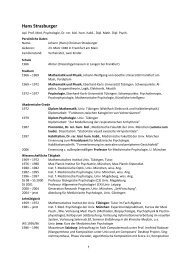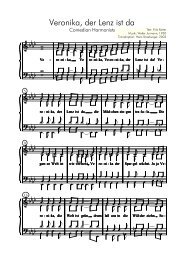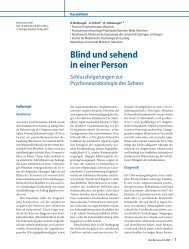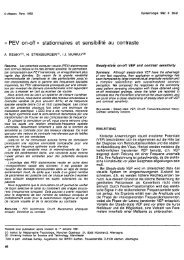Peripheral vision and pattern recognition: a review - strasburger - main
Peripheral vision and pattern recognition: a review - strasburger - main
Peripheral vision and pattern recognition: a review - strasburger - main
You also want an ePaper? Increase the reach of your titles
YUMPU automatically turns print PDFs into web optimized ePapers that Google loves.
<strong>Peripheral</strong>_Vision.doc<br />
E 2 <strong>and</strong> M values estimated from psychophysics, fMRI, <strong>and</strong> EEG<br />
Study Task / Stimuli E 2 (deg) M 0<br />
Methodology<br />
ΨΦ Cowey & Rolls (1974) Phosphenes (Brindley &<br />
Lewin, 1968) + MAR<br />
(Wertheim 1894)<br />
ΨΦ<br />
ΨΦ<br />
Rovamo & Virsu<br />
(1979)<br />
Vakrou, Whitaker,<br />
McGraw, McKeefry<br />
(2005)<br />
MRI /<br />
lesions<br />
mfVEP Slotnick, Klein,<br />
Carney, Sutter (2001)<br />
fMRI<br />
fMRI<br />
fMRI<br />
1.746 M 0 =8.55<br />
mm/°<br />
Scaled gratings 3.0 M 0 =7.99<br />
mm/°<br />
temporal 2-afc<br />
L/M: 0.91 or 0.75<br />
L/M: 0.1°<br />
color grating CSF<br />
S/(L+M): 8.1 or 8.5<br />
S/(L+M): 0.15°<br />
Achrom.: 2.4 or 1.6<br />
Horton & Hoyt (1991) Perimetry, 3 patients 0.75 M 0 =23.1<br />
mm/°<br />
M-scaled checkerboard 0.20±0.26 • 0.92±0.28 (sj TC) M 0 =43,4 ±<br />
segments, 37.5 Hz. 0.10±0.39 • 0.48±0.18 (sj HB) 9,6 mm/° (*)<br />
Dipole source distance <strong>and</strong> 0.68±0.49 • 0.52±0.11(sj SD) (goes up to<br />
200!)<br />
size<br />
Weighted mean 0.50±0.08<br />
Duncan & Boynton<br />
(2003)<br />
Larsson & Heeger<br />
(2006)<br />
Henriksson, Nurminen,<br />
Hyvärinen, Vanni<br />
(2008)<br />
Achrom: 0.8°<br />
Checkerboard rings 8Hz 0.831 M 0 =18.5<br />
mm/°<br />
Checkerboard exp<strong>and</strong>ing 0.785 M 0 =22.5<br />
ring 0.375°/TR) +<br />
mm/°(*)<br />
rotating wedge 15°/TR<br />
b/w sinewave-modulated<br />
rings<br />
1,007 (ν=1/optimum_SF for<br />
V1, derived from text to Fig. 6,<br />
p. 7 top, r 2 =99%)<br />
ν=0.55°(*)<br />
Table 5. E 2 <strong>and</strong> M 0 values obtained with non-invasive objective techniques, with psychophysical studies (ΨΦ) added<br />
for comparison. Asterisks (*) denote values added by Strasburger.<br />
Threshold task<br />
(K) Foveal S E 2 (S –1 ) Source on which estimate is based<br />
value<br />
(arc min)<br />
Unreferenced motion 0.56 0.18 5.6 Levi et al., 1984<br />
Panum’s areas 6.5 0.18 5.6 Ogle & Schwartz, 1959<br />
Grating acuity 0.625<br />
0.6<br />
0.38<br />
0.37<br />
2.6<br />
2.7<br />
Slotnick et al., 2001<br />
Virsu et al., 1987<br />
L<strong>and</strong>olt C acuity 0.57 0.88 1.14 Virsu et al., 1987<br />
1.5 1.0 1.0 Weymouth, 1958Weymouth, 1958 (low luminance <strong>and</strong><br />
short exposure)<br />
Referenced or relative motion 0.19 0.95 1.05 Levi et al., 1984<br />
Stereoscopic acuity 0.1 1.23 0.81 Fendick & Westheimer, 1983<br />
Vernier acuity 0.16<br />
0.44<br />
1.43<br />
1.57<br />
0.7<br />
0.64<br />
Levi et al., 1985<br />
Weymouth, 1958 (Bourdon’s data)<br />
Table 6. E 2 values from Drasdo (1991, Table 19.2 on p. 258) for the horizontal meridian.<br />
3.3 Schwartz’s logarithmic mapping onto the cortex<br />
The cortical magnification factor M relates cortical sizes to retinal sizes. It is a local mapping in<br />
that a small circular patch in the visual field is mapped onto an elliptical area in one of the early<br />
visual areas. From the relationship M(E), one can, under the assumption of retinotopy, derive<br />
22






